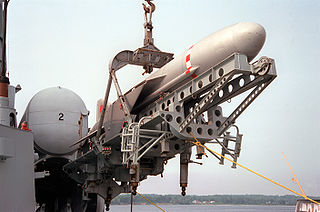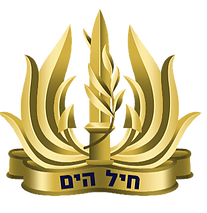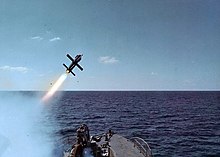
An anti-ship missile (AShM) is a guided missile that is designed for use against ships and large boats. Most anti-ship missiles are of the sea skimming variety, and many use a combination of inertial guidance and active radar homing. A large number of other anti-ship missiles use infrared homing to follow the heat that is emitted by a ship; it is also possible for anti-ship missiles to be guided by radio command all the way.

The Battle of Latakia was a small but revolutionary naval action of the Yom Kippur War, fought on 7 October 1973 between Israel and Syria. It was the first naval battle in history to see combat between surface-to-surface missile-equipped missile boats and the use of electronic deception.

The P-15 Termit is an anti-ship missile developed by the Soviet Union's Raduga design bureau in the 1950s. Its GRAU designation was 4K40, its NATO reporting name was Styx or SS-N-2. China acquired the design in 1958 and created at least four versions: the CSS-N-1 Scrubbrush and CSS-N-2 versions were developed for ship-launched operation, while the CSS-C-2 Silkworm and CSS-C-3 Seersucker were used for coastal defence. Other names for this basic type of missile include: HY-1, SY-1, and FL-1 Flying Dragon, North Korean local produced KN-1 or KN-01, derived from both Silkworm variants and Russian & USSR P-15, Rubezh, P-20 P-22.

The Israeli Navy is the naval warfare service arm of the Israel Defense Forces, operating primarily in the Mediterranean Sea theater as well as the Gulf of Eilat and the Red Sea theater. The current commander in chief of the Israeli Navy is Aluf David Saar Salama. The Israeli Navy is believed to be responsible for maintaining Israel's offshore nuclear second strike capability.

The Sa'ar 4 or Reshef class were a series of fast attack craft built based on Israeli Navy designs grounded in accumulated experience derived in the operation of "Cherbourg" classes. Thirteen were built at the Israel Shipyards, ten for the Israeli Navy and three for the South African Navy. Another six were built for the South African Navy in South Africa with Israeli assistance.

The Sa'ar 4.5-class missile boats is a class of Israeli Sea Corps missile boats designed and built by Israel Shipyards Ltd. as an improved and stretched Sa'ar 4-class missile boat. There are two different subclasses that are both named Sa'ar 4.5. The first subclass was initially called Chochit, but renamed to Aliya. Two Aliya-subclass boats are in service with the Mexican Navy. The second subclass was initially called Nirit but renamed to Hetz.

Sa'ar 5 is a class of Israeli Navy corvettes. They were Israeli designed using lessons learned from the Sa'ar 4.5-class missile boats. Three Sa'ar 5 ships were built by Huntington Ingalls Industries for the Israeli Navy, based on Israeli designs.

A missile boat or missile cutter is a small, fast warship armed with anti-ship missiles. Being smaller than other warships such as destroyers and frigates, missile boats are popular with nations interested in forming a navy at lower cost. They are similar in concept to the torpedo boats of World War II; in fact, the first missile boats were modified torpedo boats with the torpedo tubes replaced by missile tubes.

The OTO Melara 76 mm gun, being marketed as the OTO 76/62 Gun Mount, is a naval autocannon built and designed by the Italian defence company OTO Melara. It is based on the OTO Melara 76/62C and evolved toward 76/62 SR and 76/62 Strales.

A fast attack craft (FAC) is a small, fast, agile, offensive, often affordable warship armed with anti-ship missiles, gun or torpedoes. FACs are usually operated in close proximity to land as they lack both the seakeeping and all-round defensive capabilities to survive in blue water. The size of the vessel also limits the fuel, stores and water supplies. In size they are usually between 50–800 tonnes and can reach speeds of 25–50 knots (46–93 km/h).

The Typhoon is a type of remote weapon station manufactured by Rafael Advanced Defense Systems of Israel, and it shares similar design principles and common technologies with Samson Remote Controlled Weapon Station, a land-based system manufactured by the same developer. Like Samson RCWS, Typhoon is also multi-configurable.

The Super Dvora Mark III-class patrol boat is the latest generation of the Dvora family of fast patrol boats or fast attack craft (FPB/FAC). Manufactured by IAI Ramta in 2004 these vessels are capable of travelling up to 50 knots in littoral waters thanks to its state of the art thrust vectoring control Articulated Surface Drives (ASD) while holding various armaments, from automatic grenade launchers, AGM-114 Hellfire missiles, SPIKE NLOS missiles, and 30 mm cannons in its armory.

The Soviet Project 183R class, more commonly known as the Komar class, its NATO reporting name, meaning "mosquito", is a class of missile boats, the first of its kind, built in the 1950s and 1960s. Notably, they were the first to sink another ship with anti-ship missiles in 1967.

The Battle of Baltim was fought between the Israeli Navy and the Egyptian Navy on 8–9 October, 1973, during the Yom Kippur War. It took place off the Nile delta, between Baltim and Damietta. The battle began when six Israeli Sa'ar-class missile boats heading toward Port Said were engaged by four Egyptian Osa-class missile boats coming from Alexandria. It lasted about forty minutes. The Osas fired Styx missiles, missed, and began to withdraw back to Alexandria when the Israelis began to give chase. Two Osas were sunk by Gabriel missiles within a span of ten minutes, and a third was sunk twenty-five minutes later. The fourth made it back to base.

Barak 8, also known as LR-SAM or MR-SAM, is an Indo-Israeli jointly developed surface-to-air missile (SAM) system, designed to defend against any type of airborne threat including aircraft, helicopters, anti-ship missiles, and UAVs as well as ballistic missiles, cruise missiles and combat jets. Both maritime and land-based variants of the system exist.
The Second Battle of Latakia was a small naval battle of the Yom Kippur War fought on 11 October 1973 between Israel and Syria. The Israeli Navy force consisted of Sa'ar 2-class, Sa'ar 3-class, and Sa'ar 4-class missile boats armed with Gabriel anti-ship missiles while the Syrian Navy force consisted of Soviet-made Komar- and Osa-class missile boats armed with Soviet-manufactured P-15 Termit anti-ship missiles.

The EL/M-2248 MF-STAR is a multifunction active electronically scanned array naval radar system developed by IAI Elta for maritime installation on warships. It is capable of tracking both air and surface targets and providing fire control guidance. MF-STAR is an acronym of Multi-Function Surveillance, Track And Guidance Radar.
The EL/M-2258 ALPHA is a multi-function active electronically scanned array naval radar system developed by IAI Elta for maritime installation on medium-sized combat ships such as corvettes, frigates and larger vessels. It is capable of tracking both air and surface targets and providing fire control and splash spotting guidance with target classification. ALPHA is an acronym of Advanced Lightweight Phased Array Naval Radars.

INS Oz is a Sa'ar 6-class corvette of the Israeli Navy. She is the second ship of her class.



















